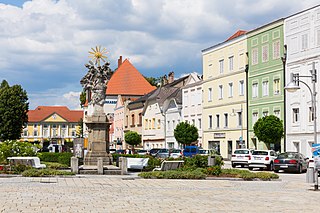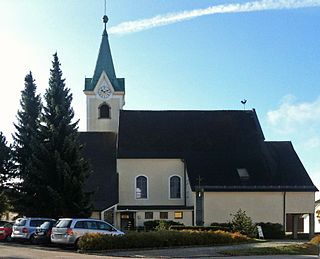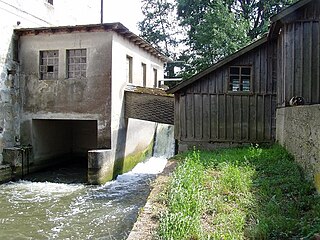
Upper Austria is one of the nine states or Länder of Austria. Its capital is Linz. Upper Austria borders Germany and the Czech Republic, as well as the other Austrian states of Lower Austria, Styria, and Salzburg. With an area of 11,982 km2 (4,626 sq mi) and 1.49 million inhabitants, Upper Austria is the fourth-largest Austrian state by land area and the third-largest by population.
Wels is a city in Upper Austria, on the Traun River near Linz. It is the county seat of Wels-Land, and with a population of approximately 60,000, the eighth largest city in Austria.

Steyr is a statutory city, located in the Austrian federal state of Upper Austria. It is the administrative capital, though not part of Steyr-Land District. Steyr is Austria's 12th most populated town and the 3rd largest city in Upper Austria.

Hainburg an der Donau is a town located in the Bruck an der Leitha district in the state of Lower Austria of eastern Austria. In 2021 it had a population of about 7,000.
Bezirk Eferding is a district of the state of Upper Austria in Austria.

Kremsmünster is a town in Kirchdorf an der Krems District, in the Austrian state of Upper Austria. Settled in 777, it is home to the Kremsmünster Abbey.

Petronell-Carnuntum is a community of Bruck an der Leitha in Austria. It is known for its annual World Theatre Festival.

Tulln an der Donau is a historic town in the Austrian state of Lower Austria, the administrative seat of Tulln District. Because of its abundance of parks and gardens, Tulln is often referred to as Blumenstadt, and "The City of Togetherness" following the initiative of Peter Eisenschenk, Mayor of Tulln.

Tamsweg is a market town in the Austrian state of Salzburg near the border with Styria. It is the administrative centre of the eponymous Tamsweg District (Bezirk) and the largest town of the Salzburg Lungau region.

Bad Deutsch-Altenburg, until 1928 Deutsch-Altenburg is a market town and spa in the district of Bruck an der Leitha in Lower Austria in Austria.

Mautern an der Donau is a town in the district of Krems-Land in the Austrian state of Lower Austria.

Eferding is the capital of the Eferding district in the Austrian state of Upper Austria.

Haibach ob der Donau is a municipality in the district of Eferding in the Austrian state of Upper Austria, Austria. It is situated near the Danube.

Vorchdorf is a market town in the district of Gmunden in Upper Austria, Austria, as well as the name of the municipal area ("Gemeinde") that the town and others occupy. As of the 2005 census, the town of Vorchdorf had a population of 7,287 inhabitants.

Windischgarsten is a municipality in the district of Kirchdorf an der Krems in the Austrian state of Upper Austria. Since 1964, the town has been classified as a Luftkurort, a mountain spa town.
Dimbach is a municipality in the district Perg in Upper Austria, Austria. It had a population of 1015 according to the 2015 census.

The Innbach is a river in Upper Austria with a length of approximately 59 km (37 mi). Its source is near Gaspoltshofen at the foot of the Hausruck hills and empties into the Danube at Wilhering. Its drainage basin covers 196 km2 (76 sq mi). After Gaspoltshofen, the Innbach passes the towns of Kematen am Innbach, Pichl bei Wels and Bad Schallerbach, at the mouth of the Trattnach. Near Eferding, it joins with the Aschach and a few kilometers later flows into the Danube downstream of the Ottensheim-Wilhering Power Station.

The Donausteig is a hiking trail that passes through parts of Bavaria and Austria. Since the summer of 2010, the trail follows both banks of the Danube, from Passau via Linz up to St. Nikola and Grein.

The County of Schaunberg was a state of the Holy Roman Empire, located in present-day Upper Austria. It roughly corresponded to the modern Hausruckviertel. Its seat was the castle of Schaunberg, Hartkirchen.
The Danubian Limes, or Danube Limes, refers to the Roman military frontier or limes which lies along the River Danube in the present-day German state of Bavaria, in Austria, Slovakia, Hungary, Croatia, Serbia, Bulgaria and Romania.




















